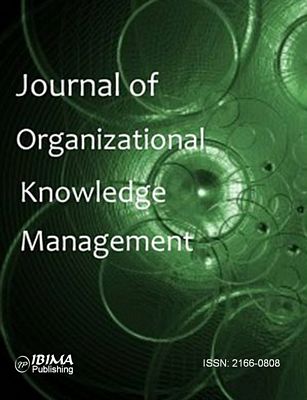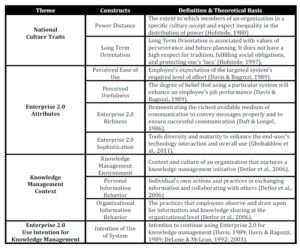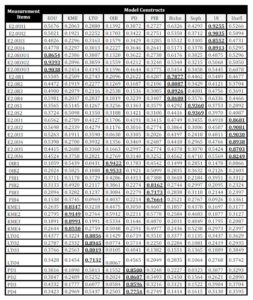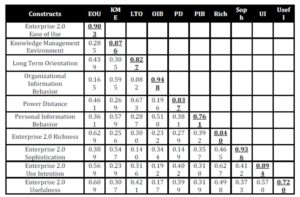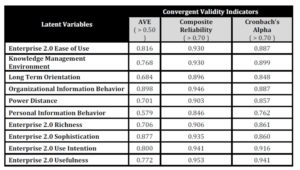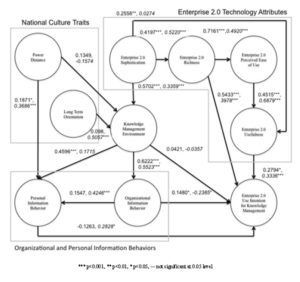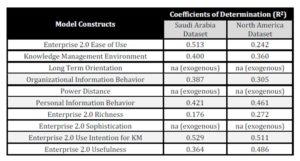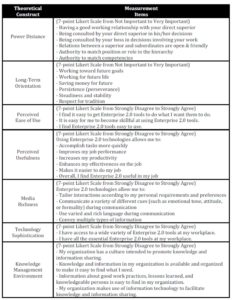Introduction
Organizational knowledge is considered an important determinant of profitability and a key driver for strategy development, value creation, and market competitiveness (Nonaka & Takeuchi, 1995; Marquardt & Kearsley, 1999; He & Wei, 2009). Consequently, effective knowledge management has been linked to overall corporate prosperity and superior business performance (Davenport & Prusak, 2000; Riege, 2005; Velev & Zlateva, 2012).
This can be achieved when organizations harness innovation and creativity by incorporating knowledge about employee experience and relations into business-specific processes (Velev & Zlateva, 2012).
On a global level, organizations worldwide are becoming increasingly aware of the benefits that can be achieved by engaging in effective knowledge management practices.
However, additional research is needed to understand how organizational settings and cultural differences can translate into varying needs and outcomes for knowledge management practices, processes and technologies.
Toward this, many researchers seek to further investigate the determinants of effective knowledge management by considering different organizational cultural contexts and industrial settings (Kim & Lee, 2006; Detlor et al., 2006; Alhamoudi, 2010). The purpose of this article is to contribute to this body of knowledge and help gain a better understanding of the cultural, organizational and technological factors affecting knowledge management behavior across multiple national and corporate settings.
Conceptual Foundation
The main research question under investigation in this study is as follows:
What are the effects of national cultural traits, organizational knowledge management context, and enterprise 2.0 technology attributes on the knowledge management practices of organizations, and consequently, the use of Enterprise 2.0 technology for knowledge management?
The conceptual framework shown in Figure 1 below depicts the overall orientation of this study and the core ideas that underpin the research investigation. The components of the conceptual framework are outlined in this section.
Adopting Davenport & Prusak’s perspective of knowledge, we describe it as actionable information that is the outcome of individual or organizational experiences and values, combined with other relevant contextual information (Davenport & Prusak, 2000).
Additionally, for this paper, knowledge management (KM) is defined as the systematic, effective management and utilization of an organization’s knowledge resources and encompasses the creation, storage, arrangement, retrieval, and distribution of an organization’s knowledge (Saffady, 1998).
The extant literature has shown that effective KM strategies and practices are predicated upon proper alignment with organization’s knowledge management context (Detlor et al., 2006).
This paper pertains to various sociological and technological factors related to the knowledge management context of an organization, and categorizes these factors as macro- or micro- context as discussed herewith.
In this paper, the macro context for KM is conceptualized using the notion of national culture. Research shows that there is a strong relationship between knowledge management and culture in that national cultural differences affect the process of knowledge management in many ways (Voelpel & Han, 2005).
As such, tools and practices suitable for one culture may not work well in another (Holden, 2002; Stankosky, 2005; Pauleen, 2007; Pawlowski & Bick, 2012). As stated by Hofstede (1980; 1997) in his seminal work on cultural dimensions theory, “there are no universal solutions to organization and management problems”, and this certainly applies to institutionalizing knowledge management practices differently across national cultures.
At a micro-level, this study explores the knowledge management setup in an organization through the lens of knowledge management environment which represents “the culture and commitment within the organization to implement and institutionalize effective information and knowledge sharing processes, practices and technologies” (Detlor et al., 2006).
A conducive knowledge management environment is seen as a key enabler that positively influences the effectiveness of KM practices (Holsapple & Joshi, 2000). Along with KME, we also explore two other related concepts — Organizational information behaviors that pertain to the information and knowledge sharing practices at the corporate level, and personal information behaviors that concern an employee’s own actions in carrying out information and knowledge sharing practices (Detlor et al., 2006). Together, these constructs aim to capture the differences among various organizational knowledge contexts.
In this paper, the sociological factors outlined above will be considered in tandem with technological factors that are posited to impact the adoption of enterprise 2.0 (E2.0) technologies in the organization.
Throughout the extant literature, there is a common theme that technology is considered to be a strong and effective enabler of KM best practices (Alavi & Leidner, 2001; Davenport & Prusak, 2000; Richter et al., 2013).
However, traditional knowledge management systems (KMS) have been known to be rigid in their deployment and use, and suffer from many limitations (Richter et al., 2013; Ruhi & Choi, 2013), and organizations today need interactive KM technologies in order to foster social processes core to knowledge management practices (Ardichvili et al., 2003). This may be made possible through the use of E2.0 technologies (Richter et al., 2013).
In this paper, the term Enterprise 2.0 is used to refer to social computing platforms and channels (e.g. blogs, wikis, social networks, multimedia sharing sites) that can be used in organizations to support collaborative knowledge work.
McAfee (2006) defines Enterprise 2.0 as the strategic integration of Web 2.0 technologies into an organization’s intranet, extranet, and business processes. In the preceding definition, Web 2.0 refers to web applications that facilitate content creation, information sharing, interoperability, user-centered design, and enhanced collaboration (O’Reilly, 2007).
In a KM context, such online interactive social applications are promising as they can help enable people to connect, communicate, collaborate and share information more actively than what was possible in traditional KMS (Kane et al., 2009; Zheng et. al, 2010). The use of such technologies for KM also marks a technology shift from a centralized knowledge-warehouse approach to a more dynamic, communication-based or network approach (Kuhlen, 2003; Hazlett et al., 2005).
Theoretical Model
To proceed with the investigation of sociological and technological factors affecting the use of enterprise 2.0 technologies for knowledge management, a theoretical model was formulated to test and validate various relationships among constructs related to national cultural traits, enterprise 2.0 technology attributes, organizational and personal information behaviors, knowledge management environment, and the use of enterprise 2.0 technologies for knowledge management. Figure 2 depicts the theoretical model for this research study.
Figure 2: Theoretical Model for This Study
In formulating the theoretical model, this research draws upon five key theoretical frameworks from the extant literature: Hofstede’s National Culture Dimensions (Hofstede, 1980; 1997), Davis et al.’s Technology Acceptance Model (TAM) (Davis, 1989; Davis et al., 1989), Daft and Lengel’s Media Richness Theory (Daft & Lengel, 1986), DeLone and McLean’s Information Systems Success Model (DeLone & McLean, 1992; DeLone & McLean, 2003), and Detlor et al.’s Knowledge management Context model (Detlor et al., 2006).
Table 1 summarizes the various themes and constructs in the theoretical model and provides a brief description for each construct in the model. The constructs and interrelated propositions are described below.
Table 1: Theoretical Model Components
Firstly, with respect to national cultural traits, the theoretical model in this study posits espoused national cultural values as individual difference variables that affect the knowledge management environment and practices in the organization.
We draw upon Hofstede’s National Culture Dimensions (Hofstede, 1980; 1997) and consider the two dimensions related to power distance and long-term orientation as parameters to differentiate cultures and to measure how such values impact the workplace and employees attitudes (Boyd, 2012).
Propositions pertaining to national cultural traits are as follows:
– P1: Greater Power Distance among an organization’s employees has a positive impact on their Personal Information Management Behavior
– P2: Greater Power Distance among an organization’s employees has a positive impact on the Organization’s Knowledge management Environment
– P3: Long-Term Orientation has a positive impact on the Organization’s Knowledge management Environment
Secondly, in terms of constructs pertaining to technology attributes of enterprise 2.0, the theoretical model includes factors that are expected to impact the employee’s cognitive, affective and behavioral responses towards enterprise 2.0 technologies. The model draws upon the Technology Acceptance Model (TAM) (Davis, 1989; Davis et al., 1989) to conceptualize user acceptance of enterprise 2.0 technologies based on their perceptions of usefulness and ease of use. Additionally, media richness of E2.0 technologies was considered to be an essential determinant of adoption of these technologies. Media Richness Theory posits that the richest medium of communication is one that promotes understanding in a timely fashion; meanwhile, a channel that takes more time to understand is a less rich medium (Daft & Lengel, 1986). In determining the richness and usefulness of a medium, this study considers the sophistication of enterprise 2.0 tools in terms of the breadth of features and functions that are available to the end-user through these tools.
Propositions pertaining to technological constructs in the theoretical model are as follows:
– P4: Sophistication of Enterprise 2.0 technologies has a positive impact on the Organization’s Knowledge Management Environment
– P5: Sophistication of Enterprise 2.0 technologies has a positive impact on the Richness of Enterprise 2.0 technologies
– P6: Sophistication of Enterprise 2.0 technologies has a positive impact on the Perceived Usefulness of Enterprise 2.0 technologies
– P7: Richness of Enterprise 2.0 technologies has a positive impact on the Perceived Ease of Use of Enterprise 2.0 technologies
– P9: Perceived Ease of Use of Enterprise 2.0 technologies has a positive impact on the Perceived Usefulness of Enterprise 2.0 technologies
The third grouping of constructs in the theoretical model pertains to the overall organizational knowledge management context, and it consists of the knowledge management environment, personal information behaviors, and organizational information behaviors. The operationalization of these constructs and their interrelationships is adopted primarily from Detlor et al. (2006) as outlined in the following propositions:
– P10: Organization’s Knowledge Management Environment has a positive impact on Personal Information Management Behavior
– P11: Organization’s Knowledge management Environment has a positive impact on Organizational Information Behavior
– P15: Organizational Information Management Behavior has a positive impact on Personal Information Behavior
Finally, intention to use enterprise 2.0 technologies for KM is positioned as the ultimate consequent variable in the theoretical model. This is aligned with other theoretical models in the information systems literature including the technology acceptance model (TAM) (Davis, 1989; Davis & Bagozzi, 1989) and the IS success model (DeLone & McLean, 1992; DeLone & McLean, 2003).
The extant research literature also shows the context in which the knowledge is exchanged affects employee behavior in terms of creating, transferring and sharing knowledge through appropriate technologies (Malone, 2003).
The various posited relationships between other theoretical constructs and the intention to use E2.0 technologies for KM are as follows:
– P8: Richness of Enterprise 2.0 technologies has a positive impact on the Intention to Use Enterprise 2.0 technologies for Knowledge Management
– P12: Organization’s Knowledge Management Environment has a positive impact on the Intention to Use Enterprise 2.0 technologies for Knowledge Management
– P13: Perceived Usefulness of Enterprise 2.0 technologies has a positive impact on the Intention to Use Enterprise 2.0 technologies for Knowledge Management
– P14: Personal Information Behavior has a positive impact on the Intention to Use Enterprise 2.0 technologies for Knowledge Management
– P16: Organizational Information Behavior has a positive impact on the Intention to Use Enterprise 2.0 technologies for Knowledge Management
Methodology
Data for this study were collected through an online survey that was administered to employees of various organizations across three countries — Canada, USA and Saudi Arabia. For respondents in Saudi Arabia, the survey questionnaire was accessible in both English and Arabic.
Call for participation in the research study was communicated through personal contact with key personnel in various organizations, and it was also posted on various open and closed online social networks. The sampling techniques used were primarily convenience and self-selection based. Qualifying questions were asked at the beginning of the survey to ensure that respondents had some familiarity with social media tools for knowledge work in an organizational context.
The survey comprised demographic information questions, technographic behavioral items, questions about work atmosphere, and psychographic perceptions based questions. While the demographic and technographic sections of the survey were operationalized through direct questions consisting of an inventory of possible responses, the questions pertaining to constructs in the theoretical model comprising latent variables were operationalized using psychometric scales with responses on a Likert-scale and through categorical response type questions.
Furthermore, most survey questions pertaining to the theoretical constructs were adapted from item scales that had been previously used and validated in other research. Appendix A lists the survey measurement items that were utilized for each of the constructs in the theoretical model.
Prior to rollout, a draft version of the survey was pre-tested using 15 respondents from the planned sampling frame, allowing the language of the survey to be improved, words to be better translated and item measurement scales to be verified. Pre-testing of a survey instrument is regarded as a crucial step in the development and design of a survey questionnaire ensuring the adequacy of planned survey administration and data collection procedures (Andrews et al., 2001).
In terms of analysis procedures, the demographic and technographic variables were analyzed using descriptive statistics and non-parametric statistical tests. Testing of theoretical constructs and relational propositions from the theoretical model was conducted through exploratory factor analysis and structural equation modeling techniques.
To examine the measurement model, the two-step approach suggested by Anderson and Gerbing (1988) was utilized whereby examination of the measurement model was conducted before testing the structural model. Both the measurement and structural models were estimated by using the structural equation modeling facilities of Smart PLS (Ringle et al., 2013).
The PLS approach was chosen since it fits small-sample exploratory research (Gefen et al., 2000) and it does not require meeting the multivariate normality assumptions posed by other structural equation modeling techniques (Thomas et al., 2005).
Harman’s post hoc one-factor test (Podsakoff et al., 2003) was conducted to examine common method bias in the data. Principal component factor analysis (unrotated solution) revealed that nine factors were extracted and the first factor accounted for 26% of the variance. Hence, common method bias was not a serious problem with the data because multiple factors emerged and no single factor accounted for a majority of the variance (Podsakoff and Organ, 1986; Podsakoff et al., 2003).
Results
A total of 350 responses were collected from across the three countries. After discarding partial responses, a total of 85 responses from Saudi Arabia and a total of 91 responses from North America (43 from Canada and 48 from USA) were retained for statistical analysis. Statistical analysis was conducted separately on these two datasets from Saudi Arabia and North America.
With respect to demographics, the average age of respondents fell around the 30—39 years frequency category for both samples. Males comprised 52% of the sample from Saudi Arabia, and 58% of the sample from North America.
In other words, the majority of respondents were male. 42% of respondents from Saudi Arabia had undergraduate degrees while 48% of North American respondents had graduate degrees. Majority of the respondents from both samples reported working in middle management back-office positions in large organizations (firms with more than 1000 employees).
With respect to technographic patterns in the behavior of using enterprise 2.0 technologies, most Saudi Arabian respondents reported using these technologies primarily for internal communication purposes within the organization.
In contrast, respondents from Canada and the US reported internal collaboration being the most common use for enterprise 2.0 technologies. Furthermore, the results indicated that most Saudi Arabian employees use these tools for personal communication purposes rather than work related purposes.
This pattern can possibly be related to another finding that suggested that companies in Saudi Arabia lagged behind those in Canada and the USA in terms of clearly defined guidelines and policies for the use of social media tools at the workplace.
The measurement model was assessed by combining the data from the two samples. Tables 2, 3 and 4 consist of matrices showing various tests for discriminate and convergent validities for the constructs in the theoretical model.
First, the loadings and cross-loadings of indicators were examined as a basic test for discriminant validity of measures.
The matrix of loadings and cross-loadings is presented in Table 2 with the highest loadings of items shown in bold. In order to ascertain discriminant validity, the loadings of an item on its associated latent construct (target variable) should be higher in comparison to the item’s cross-loadings on other latent constructs. All model constructs satisfied these criteria.
Table 2: Matrix of Loading and Cross Loadings
Second, a test of discriminant validity as per Fornell and Larcker (1981) was conducted to ensure that the constructs of Power Distance, Long-Term Orientation, Knowledge Management Environment, Personal Information Behavior, Organizational Information Behavior, E2.0 Technology Sophistication, E2.0 Media Richness, E2.0 Perceived Usefulness, E2.0 Perceived Ease of Use, and E2.0 Use Intention were all distinct.
A visual inspection of Table 3 shows that the square root of the average variance shared by items within a construct (shown in bold on the diagonal) exceeds the inter-construct correlations that appear below and beside them. All model constructs satisfied these criteria.
Table 3: Average Variance Extracted and Inter-Construct Correlations
Third, various tests of convergent validity were performed through an assessment of various quality indices as shown in Table 4. As shown, the AVE value for each latent variable is higher than 0.5, indicating that at least 50% of the variance in each block of indicators can be attributed to the pertinent latent variables (Fornell and Larcker 1981; Chin, 1998).
Moreover, the values of Cronbach’s alpha exceeding 0.70 shows the internal reliability consistency of construct at an individual level (Gefen et al., 2000). Furthermore, composite reliability values for each construct are higher than 0.70 which is the recommended cut-off to validate the internal reliability consistency relative to all other constructs in the model (Fornell and Larcker, 1981).
Table 4: Convergent Validity Assessment of the Measurement Model
In order to estimate the structural model, this study used a bootstrapping procedure to derive t-statistics for the structural paths and assess the significance of the path beta coefficients in the structural model. Specifically, bootstrapping with 1000 replications was performed to provide a more conservative test of parameter significance (Chin, 2001).
The structural model and the p-values are presented in Figure 3 with results from the two rounds of validation depicted along each path in order of Saudi Arabia and North America (values for the latter also shown as italicized). The main conclusion drawn from the reported structural model analysis as depicted in Figure 3 is that most of the proposed paths are supported with high degrees of confidence.
As predicted (P1), Power Distance had a significant positive effect on Personal Information Behavior in both models.
However, no significant relationship emerged between Power Distance and Knowledge Management Environment (P2). P3, concerning the hypothesized effect of Long-Term Orientation, was only supported for the North American dataset, but did not reach significance with the Saudi Arabia sample. E2.0 Technology Sophistication had significant positive effects on Knowledge Management Environment in both samples, thus supporting P4. Also, as predicted in P5, E2.0 Technology Sophistication had significant direct impact on E2.0 Media Richness in both samples. P6, concerning the hypothesized effect of E2.0 Technology Sophistication on Usefulness, was supported for the Saudi Arabia dataset, but not for the North American sample. P7 and P8 pertaining to the effect of E2.0 Media Richness on Perceived Ease of Use and E2.0 Use Intention for KM was supported for both samples.
Similarly, the effect of Perceived Ease of Use on Perceived Usefulness (P9) was supported in both datasets. Proposition P10 which hypothesized a relationship between Knowledge Management Environment and Personal Information Behavior was only supported in the Saudi Arabia dataset.
Contrary to expectations, Knowledge Management Environment did not have a direct positive effect on Enterprise 2.0 Use Intention for KM (P12) in either model. However, a test of mediation showed that for both datasets, Organizational Information Behavior fully mediates this effect.
As anticipated, the effect of Perceived Usefulness of E2.0 technologies on E2.0 Use Intention (P13) was supported in both datasets. P14, concerning the hypothesized effect of Personal Information Behavior on E2.0 Use Intention for KM was supported for the North American dataset, but not for the Saudi Arabia sample.
The proposition concerning the direct positive effect of Organization Information Behavior on Personal Information Behavior (P15) was supported for the North American sample but not for the Saudi Arabia sample. Finally, while Organizational Information Behavior had a significant effect on E2.0 Use Intention for KM (P16) in both models, for the North American sample, a negative path coefficient emerged.
Figure 3: Theoretical Model Path Coefficients
In determining the efficacy of the model in terms of predictability, an evaluation of the coefficients of determination (R2) suggested that the model performed well for most downstream endogenous variables. The coefficients of determination (R2) explain the proportion of a construct’s variance that can be predicted by antecedent constructs in the model.
While there is no specific cut-off value for measuring R2, generally higher values are considered favorable (Gefen et al., 2000), and some researchers suggest that values higher than 0.10 can be deciphered to indicate the usefulness of an endogenous variable within the model (Falk & Miller, 1992). Table 5 below provides the values of the coefficient of determination for all inner model constructs.
As seen, most variables compellingly exceed the minimum level of 0.10, with the exception of E2.0 Media Richness for which the value is only slightly above 0.10. This should not be a concern since this construct only has one incoming path from other constructs that act as their antecedents. In terms of the ultimate criterion variable in the model, i.e. E2.0 Use Intention for KM, a significant portion of its variance (around 52%) can be explained by the model for both datasets.
Table 5: Coefficients of Determination (R2) for Model Constructs
For assessing the goodness of fit for the structural model, we used the global criterion of goodness-of-fit (0 <= GoF <=1) to evaluate the model fit (Tenenhaus et al., 2005).
This test is defined as the geometric mean of the average communality (AVE) and the average of the R2 values (for endogenous constructs) (Tenenhaus et al., 2005; Wetzels et al., 2009).
For the two rounds of validation, the resulting GoF values of 0.563 and 0.522 both exceeded the cut-off value for large effect sizes (R2) of 0.35. Hence, it can be inferred that the structural model performed well in both rounds of validation.
Discussion
The findings outlined in the previous section confirm the general premise that national cultural traits, organizational knowledge management context, and enterprise 2.0 technology attributes play an important role in determining the knowledge management practices of organizations, and consequently, the use of enterprise 2.0 technology for knowledge management.
As such, we would recommend that knowledge management researchers further explore and investigate these sociological and technological constructs related to the use of E2.0 technology for KM to gain a better understanding of the differences among adoption and acceptance of these technologies.
Likewise, practitioners should pay more attention to ensuring that relevant E2.0 tools are available according to the needs and preferences of the organization and its employees. Furthermore, they should ensure the presence of a conducive corporate-wide knowledge management environment comprising effective practices, policies and processes for KM initiatives.
In terms of similarities and differences among national culture traits, our results support the proposition that greater power distance leads people to take it upon themselves to communicate internally and share information, and it does not support a positive knowledge management environment in the enterprise.
This was validated in both datasets implying that a hierarchical centralized structure does not support a collaborative knowledge culture. For long-term orientation, our results were inconclusive in that its link to knowledge management environment was not supported in the Saudi Arabian context.
This may be explained through complementary findings in our survey that suggested that for the most part, strategies and practices related to knowledge management are still in their infancy in that country. Hence, responses to our survey did not validate a significant positive or negative link between long-term orientation and knowledge management environment.
Generally, our results indicated that KM oriented strategies and the use of E2.0 for KM specific purposes are in their early stages in Saudi Arabia, while in North America, processes, practices, policies and technologies related to knowledge management are more mature. This finding has multiple implications and helps explain some of the results from our structural model.
Firstly, personal information behaviors in Saudi Arabia are not impacted by organizational information behaviors since the information and knowledge sharing practices at the corporate level are still not well established in these firms. This outcome is also supported through responses to our technographic questions which indicated that most individuals in Saudi Arabia use social media tools for personal internal communication purposes rather than collaboration and knowledge sharing purposes.
Secondly, in terms of technology use, it can be seen that in the context of North America, both Organizational and Personal Information Behaviors affect intention to use E2.0 tools for KM purposes, while in the case of Saudi Arabia, only the former was a significant determinant.
This shows that personal information sharing and communication behaviors are not sufficient to sustain the use of E2.0 technologies for KM, and organizations really need to foster a corporate-wide culture of information sharing and knowledge transfer in order to stimulate and promote the use of enterprise 2.0 technologies for knowledge management purposes. Based on the path coefficient values in the structural model, it can also be argued that Organizational Information Behavior may play a more important role in the development period of KM strategy formulation and the early days of E2.0 technology use for KM.
This is evident in the positive significant effect of organizational information behavior on enterprise 2.0 use for knowledge management in the context of Saudi Arabia.
Once a favorable knowledge management culture is present, people may take the initiative on their own to improve the use of enterprise 2.0 technologies for knowledge management purposes — as observed in the significant positive impact of personal information behavior on E2.0 use for KM in the Canada and US dataset. Flexibility in use of corporate social software has been regarded as a primary driver for using such tools for knowledge management (Richter et al., 2013).
Thirdly, with respect to the variety of features and functions of enterprise 2.0 tools, our model showed a significant positive relationship between E2.0 sophistication and perceived usefulness for the Saudi Arabia dataset but not the North American dataset.
Once again, this may be attributed to the embryonic nature of KM strategies and technologies in the Saudi Arabia context at the current time. Organizations in such a setting may still be experimenting with a variety of social media tools to understand and cater to employee needs and requirements of their knowledge intensive processes, and hence the availability of a breadth of social media channels and platforms translates into higher perceptions of usefulness.
In contrast, in the North American context, the E2.0 technology base may be more evolved and stable, and variety does not necessarily translate into higher levels of perceived usefulness.
As far as the enabling role of E2.0 technologies for KM is concerned, our model clearly showed a significant positive impact of E2.0 technology sophistication and knowledge management environment in both datasets.
This highlights the value and utility of these technologies in promoting a knowledge sharing corporate culture by facilitating organized and accessible information, and enabling the sharing of best practices across the organization.
Furthermore, it can be argued that the relationship among E2.0 technologies for KM and the organizational KM environment is reciprocal and mutually reinforcing. A test of mediation was conducted to evaluate the relationship between the organizational KM environment and the intention to use E2.0 tools for KM.
Organizational Information Behavior was shown to fully mediate the effect of organizational KM environment on the intention to use E2.0 tools for KM. This result is noteworthy since it was supported for both datasets suggesting that the adoption and acceptance of KM technologies is a gradual process that requires the presence of a favorable knowledge management culture in the organization as well as visible and recognizable information sharing and knowledge collaboration practices across the enterprise.
Our results lend strong support to the knowledge management context model proposed by Detlor et al. (2006) where the researchers purported links between knowledge management environment, personal information behavior, and organizational information behavior. As noted above, these links were validated in either one or both of our datasets.
Furthermore, through our work, we have attempted to answer the call for additional research by the authors of the original model. Our model extends their work by offering additional sociological and technological constructs that can help explain the variance in organizational and personal information behaviors.
As shown in Table 5, our model is able to account for the variance of organizational information behavior in the range of 0.31 (North America) to 0.40 (Saudi Arabia), and in the range of 0.42 (Saudi Arabia) to 0.46 (North America) for personal information behavior. This is in contrast to the variance for these variables reported in the range of 0.17 to 0.19 in the original model by Detlor et al. (2006).
In terms of limitations, this study is constrained by the investigation of knowledge management practices and enterprise 2.0 technology use using convenience and self-selection sampling techniques. This may limit the generalizability of the study’s results. However, to some extent, the validation of the theoretical model in multiple national and industrial contexts mitigates this limitation.
Future studies wishing to explore further the effects of national and organizational culture, and technology characteristics on knowledge management practices and technology use may wish to adopt this study’s research model as a theoretical basis.
The model confirms and extends Detlor et al.’s (2006) model and highlights the importance of knowledge management culture and information behaviors at organizational and individual levels on the overall effectiveness of KM practices and the use of enterprise 2.0 technologies for KM purposes. Researchers also may wish to carry out the investigation in additional regional and industrial contexts for purposes of comparison.
Finally, we believe it would be very fruitful to conduct a focused investigation using case-studies of organizations that may be in different stages of use of enterprise 2.0 tools for knowledge management.
Conclusion
This paper presented research results of an empirical investigation of sociological and technological factors affecting knowledge management practices and the use of enterprise 2.0 technologies for knowledge management in organizations.
Results indicate that national culture traits and corporate KM culture play an important role in influencing personal and organizational information behavior, as well as the use of enterprise 2.0 technologies for KM. Additionally, the availability of a variety of enterprise 2.0 tools is critical in the early stages of KM strategy development as these tools help foster a positive knowledge management environment in the organization.
The extension of Detlor et al.’s model with national culture traits and technology attributes has important practical and theoretical value, but additional research is needed. As organizations continue to experiment with social media channels and platforms for knowledge sharing and collaboration, they also need to continue their efforts to improve the culture, processes and practices around information sharing, and the transfer of embedded and encoded knowledge across the enterprise.
References
1. Alavi, M., & Leidner, D. E. (2001). Review: Knowledge management and knowledge management systems: Conceptual foundations and research issues. MIS Quarterly, 25(1), pp. 107-136.
Publisher – Google Scholar
2. Alhamoudi, Salwa. (2010). Strategic KM system in public sector in Saudi Arabia: an adaptation of the Balanced Scorecard. PhD thesis, University of Portsmouth.
Google Scholar
3. Anderson, J. C., & Gerbing, D. W. (1988). Structural Equation Modeling in practice: A review and recommended two-step approach. Psychological Bulletin, 103(3), 411-423.
Google Scholar
4. Andrews, D., Preece, J., and Turoff, M. “A Conceptual Framework for Demographic Groups Resistant to Online Community Interaction,” 34th Annual Hawaii International Conference on System Sciences, Maui, Hawaii, 2001.
5. Ardichvili, A., Cardozo, R. and Ray, S. (2003). A Theory of Entrepreneurial Opportunity Identification and Development, Journal of Business Venturing, 18/1, pp. 105-123.
Publisher – Google Scholar
6. Boyd, Michael (2012). Hofstede’s Cultural Attitudes Research – Cultural Dimensions, Retrieved March 20th, 2012 http://www.boydassociates.net/Stonehill/Global/hofstede-plus.pdf
7. Chin, W. W. (1998). Issues and opinion on structural equation modeling. Management Information Systems Quarterly, (22:1), pp. 7-16.
8. Chin, W.W. “PLS-graph user’s guide version 3.0,” Soft Modeling Inc, 2001.
Google Scholar
9. Daft, R. L., & Lengel, R. H. (1986). Organizational information requirements, media richness and structural design. Management Science, 32(5), pp. 554-71.
10. Davenport, Thomas H., Prusak, Laurence (2000). Working Knowledge: How Organizations Manage What they Know. Harvard Business School Press, pp. 240. ISBN 1-57851-301-4.
11. Davis, F. D. (1989). Perceived usefulness, perceived ease of use, and user acceptance of information technology. MIS Quarterly, 13(3), pp. 319-340.
Publisher – Google Scholar
12. Davis, F. D., Bagozzi, R. P., & Warshaw, P. R. (1989). User acceptance of computer technology: A comparison of two theoretical models. Management Science, 35, pp. 982—1003.
Publisher – Google Scholar
13. DeLone, W. H. and McLean, E. R. (1992). Information Systems Success: The Quest for the Dependent Variable. Information Systems Research, Vol. 3, No. 1, pp. 60-95.
Publisher – Google Scholar
14. DeLone, W. H. and McLean, E. R. (2003). The DeLone and McLean Model of Information Systems Success: A Ten-Year Update. Journal of Management Information Systems, Vol. 19, No. 4, pp. 9-30.
Google Scholar
15. Detlor, B., Ruhi, U., Turel, O., Bergeron, P., Choo, C. W., Heaton, L., & Paquette, S. (2006). The effect of KM context on KM practices: An empirical investigation. The Electronic Journal of Knowledge Management, 4(2), pp. 117-28. Available at www.ejkm.com
Google Scholar
16. Falk, R.F., and Miller, N.B. (1992). A primer for soft modeling University of Akron Press Akron, OH.
17. Fornell, C., and Larcker, D.F. “Structural equation models with unobservable variables and measurement error: algebra and statistics,” Journal of Marketing Research) 1981, pp 382-388.
Publisher – Google Scholar
18. Gefen, D., Straub, D. W., & Boudreau, M.-C. (2000). Structural Equation Modeling and Regression: Guidelines for research practice. Communications of the Association of Information Systems, 4(7), 1-77.
Google Scholar
19. Ghobakhloo, M., Benitez-Amado, J., & Arias-Aranda, D. (2011a). Reasons for information technology adoption and sophistication within manufacturing SMEs. Paper presented at the POMS 22nd Annual Conference: Operations management: The enabling link. Reno, USA, April 29 to May 2, 2011.
20. Hazlett, S.A., McAdam, R. and Gallagher, S. (2005). “Theory building in knowledge management: in search of paradigms.” Journal of Management Inquiry, Vol. 14 No. 1, pp. 31-42.
Publisher – Google Scholar
21. He, W. and Wei, K. K. (2009). What drives continued knowledge sharing? An investigation of knowledge contribution and -seeking beliefs. Decision Support Systems, Vol. 46, No. 4, pp. 826-838.
Publisher – Google Scholar
22. Hofstede, G. (1980). Culture’s Consequences: International differences in work related values. Beverly Hill, CA, Sage.
23. Hofstede, G.H. (1997). Cultures and Organizations: Software of the mind. London. McGraw-Hill.
24. Holden, N.J. (2002) Cross-cultural Management: A Knowledge Management Perspective. London: Financial Times/ Prentice Hall.
Google Scholar
25. Holsapple, C. W. & Joshi, K. D. (2000). An investigation of factors that influence the management of knowledge in organizations. Journal of Strategic Information Systems, 9(2/3), pp. 235-261.
Publisher – Google Scholar
26. Kane, J., Robinson-Combre, J., and Berge, Z. L. (2009). Tapping into social networking: Collaborating enhances KM and e-learning. Journal of Information and Knowledge Management Systems. Vol. 40, No. 1, pp. 62-70.
27. Kuhlen, R. (2003), “Change of paradigm in knowledge management — framework for the collaborative production and exchange of knowledge.” Paper presented at the 69th IFLA General Conference and Council, 30 August 2003, Berlin.
28. Kim, S. and Lee, H. (2006). “The impact of organizational context and information technology on employee knowledge-sharing capacities.” Public Administration Review, Vol. 66 No. 3, pp. 370-85
Publisher – Google Scholar
29. Malone, T. W. (2003). Organizing business knowledge: The MIT process handbook. Cambridge, MA: MIT Press.
Google Scholar
30. Marquardt, M. and Kearsley, G. (1999). Technology-based learning: Maximizing human performance and corporate success. Boca Raton: CRC Press LLC.
31. McAfee, A. P. (2006). Enterprise 2.0: The dawn of emergent collaboration. Engineering Management Review, IEEE, 34(3), pp. 38-38.
Publisher – Google Scholar
32. Nonaka, I. and Takeuchi, H. (1995). The Knowledge-Creating Company: How Japanese Companies Create the Dynamics of innovation. New York: Oxford University Press.
Google Scholar
33. O’Reilly, T. (2005). What Is Web 2.0. Design Patterns and Business Models for the Next Generation of Software. Retrieved November 16th, 2011. http://oreilly.com/web2/archive/what-is-web-20.html.
34. Pauleen, D. (2007). Cross-cultural perspectives on knowledge management. Westport, Conn., Libraries Unlimited.
35. Pawlowski, J. M., & Bick, M. (2012). The global knowledge management framework: Towards a theory for knowledge management in globally distributed settings. Electronic journal of knowledge management, 10(1), pp. 92-108.
Google Scholar
36. Podsakoff, P.M., MacKenzie, S.B., Lee, J.Y., and Podsakoff, N.P. “Common method biases in behavioral research: A critical review of the literature and recommended remedies,” Journal of Applied Psychology (88:5) 2003, pp 879-903.
Google Scholar
37. Podsakoff, P.M., and Organ, D.W. “Self-reports in organizational research: Problems and prospects,” Journal of Management (12:4) 1986, p 531.
Google Scholar
38. Richter, A., Stocker, A., Müller, S., & Avram, G. (2013). Knowledge management goals revisited: A cross-sectional analysis of social software adoption in corporate environments. VINE, 43(2), 132-148.
Publisher – Google Scholar
39. Riege, A. (2005). Three-dozen knowledge-sharing barriers managers must consider. Journal of KM, Vol. 9, pp. 18-35.
Publisher – Google Scholar
40. Ringle, Christian M., Wende, Sven, & Becker, Jan-Michael. (2013). Smartpls 3. Hamburg: SmartPLS. Retrieved from http://www.smartpls.com
41. Ruhi, U. and Choi, D. (2013). Enterprise Mashups for Knowledge Management. Proceeding of 1st International Conference on Information and Communication Technology Trends (ICICTT).
42. Saffady, W. (1998). Knowledge management: A manager’s briefing. Prairie Village, KS: ARMA International.
43. Stankosky, M. (2005). Creating the discipline of knowledge management: the latest in university research.Amsterdam. Boston, Elsevier Butterworth-Heinemann.
Google Scholar
44. Tenenhaus, M., Vinzi, V.E., Chatelin, Y.M., and Lauro, C. (2005). “PLS path modeling.” Computational Statistics and Data Analysis (48:1), pp. 159-205.
Google Scholar
45. Thomas, R. D., Lu, I. R. R., & Cedzynski, M. (2005). Partial Least Squares: A critical review and a potential alternative. Proceedings of the Administrative Sciences Association of Canada (ASAC ) Conference, Toronto, Ontario, Canada.
46. Velev, Dimiter and Zlateva, Plamena. (2012). Current State of Enterprise 2.0 Knowledge Management. International Journal of Trade, Economics and Finance, Vol. 3, No. 4.
Google Scholar
47. Voelpel, S. C. & Han, Z. (2005). “Managing knowledge sharing in China: the case of Siemens ShareNet.” Journal of Knowledge Management, 9, pp. 51-63.
Publisher – Google Scholar
48. Wetzels, M., Odekern-Schroder, G., and Oppen, C.v. (2009) “Using PLS Path Modeling for Assessing Hierarchial Construct Models: Guidelines and Empirical Illustration.” MIS Quarterly (33:1), pp. 175-199.
Google Scholar
49. Zheng, Y., Li, L. and Zheng, F. (2010). Social Media for Knowledge Management. Knowledge Creation Diffusion Utilization, pp. 9-12.
Appendix A: Measurement Items for Theoretical Constructs



